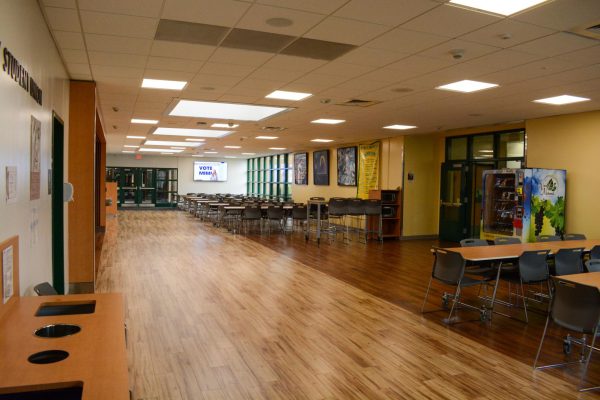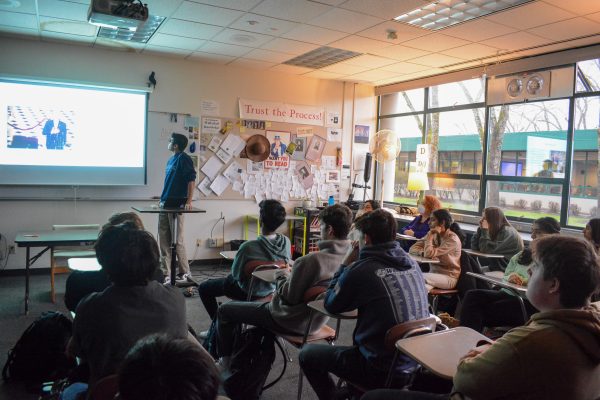Progress needed on responsive race education
Students at Jesuit have disappointingly limited educational exposure to discussions on race and identity.
Jesuit stresses the purposeful pursuit of social equity and awareness in one of its five student profile attributes: “Committed to Doing Justice.” In Peace and Justice and with inclusivity-oriented school events such as the Martin Luther King assembly and Multicultural Week, Jesuit clearly includes racial justice under the umbrella of social justice issues it seeks to expose students to.
Yet save an inevitably brief intro about the realities of racism in Peace and Justice, the times race is explicitly tackled in the classroom, in an educational environment, number very few. Many students, unless they actively seek out race education themselves, exit Jesuit with at best a surface-level, bare-minimum understanding of what marginalization means, of the aggressions both systemic and individual that compose America’s tumultuous, frustrating, ignorance-ridden racial landscape. This level of ignorance is inevitable without consistent, purposeful exposure to race and mandatory racial discussions beyond assemblies.
Depending on their English class, sophomores may read The Other Wes Moore, or All American Boys, or American Born Chinese, and discuss stereotypes and discrimination from a literary lens. Students may spend a couple U.S. History classes absorbing a strictly factual account of the Chinese Exclusion Acts or the Civil Rights era. The quality of a student’s race education is dependent upon the classes they take, and even if they maximize their exposure to discussions about race, no curriculum across different departments at Jesuit specifically embeds comprehensive, continuing, multi-year education about many critical aspects of race.
Inevitably, of course, race does intersect with certain disciplines at Jesuit. Problematically, however, many of Jesuit’s rare classroom-based explorations of race are completely unrelated to what they learn about race in the next class, making it next to impossible for students, particularly those without experience with racial discrimination, to draw connections or actually develop a nuanced understanding of racism and racial identity.
Students will obviously struggle with applying the diverse cultural experiences of authors they read in English class to the historical atrocities and institutional racism they learn about in Theology or History when there’s no continuous, interconnected educational progression guiding their understanding of race and culture. Worse yet, many topical racial issues, including issues that affect how students themselves respond to race and treat their classmates of color, go completely untouched. There are students who will leave Jesuit and never once engage in critical, intentional classroom discussions about their own implicit biases, about microaggressions, about cultural appropriation or police brutality or affirmative action.
Each and every student should be exposed to uncomfortable discussions from freshman to senior year, routinely revisiting more challenging topics and receiving exposure to cumbersome racial and cultural controversies. Without this curriculum-embedded emphasis on cultural responsiveness, many students miss out on participating in crucial, contentious political and cultural conversations, and their insularity leaves them unprepared to engage with those issues once they leave Jesuit.
Case in point: when Mosely Watta performed at the Martin Luther King assembly, he informed the student body that he would refrain from sharing his piece on cultural appropriation, which included mention of the n-word, because he didn’t feel we were ready to handle that topic—yet. Considering his audience included 14-year-old freshmen, his rationale made sense, but the connotation of the word “yet” suggests that we as a school will eventually broach discussions about cultural appropriation and have the capacity to grapple with its cultural complexity. With no intentional sequence for students to develop racial literacy skills, and no designated course that explores cultural appropriation, it’s doubtful that each and every student will ever get the chance to have a mature conversation about the n-word.
For students who want to understand cultural appropriation and other racial issues, they can; by attending the Ignatian Teach-In, for example, or participating in student-led projects and conversations with students of color, every student technically has access to race education. In all of these scenarios, however, students must dedicate extracurricular time to interacting with consistent, explicit forums about race, which means those who would benefit from race education the most don’t often receive it.
Even more concerning, without curriculum-oriented opportunities to address race and culture, a disproportionate and unfair burden falls upon the students of color already experiencing discrimination to educate their classmates on their own experiences and dedicate themselves to diversity projects, such as student panels for Ms. Myers’ Peace and Justice class and the Multicultural Week assembly.
“With this idea that it should be student-driven, it’s just really tiring,” senior Natalie Tan said. “It’s really, really tiring to actually [explain your own experiences with racism], and it takes up a lot of your energy and your time. I understand it would be most effective student-driven, but at the same time when you’re experiencing [racism] and you also have to become the person to educate, and then you have to relive everything that’s hurt you, that’s really, really emotionally draining.”
A lack of race education doesn’t simply produce a student body that is socially and culturally unresponsive in an abstract, global sense. Without a thorough understanding of race, identity, and marginalization, students are infinitely more likely to perpetuate microaggressions and indulge in racial stereotypes, even without conscious racist intent. Senior Kaylee Jeong notes that her teachers have at times refused to vocally address microaggressions as students perpetuate them against her and her classmates of color, a consequence of Jesuit’s broader aversion to confronting racism through an educational, interpersonal lens.
“I don’t need my teachers in every single class to be educating about race issues. I want to learn about biology and math, too, but I just want to be able to trust in my teachers that they’re going to be supportive of me if someone says something that hurts me in class,” Jeong said. “I want them to know why it’s problematic and be able to support me, because I don’t want that responsibility all to myself, to be like, ‘this is why you’re wrong, this is all the analysis behind it,’ while being respectful at the same time. That is so tiring.”
It’s worth noting that Jesuit is not alone in its evident lack of race education. Many high schools, even after instituting more explicit classes on racial literacy such as Ethnic Studies, still struggle with imparting universal or even near-universal lessons on race. Cleveland High School, for example, had an incident in 2018 where hate speech, including hostile use of the n-word, was graffitied in a boy’s bathroom (OregonLive).
Jesuit, in its expressed commitment to racial justice, still has a unique responsibility to try harder. To make observable changes for the benefit of racial literacy on a yearly basis, even if that means investing a lot of resources. To pursue both long-term progress towards an embedded, multi-discipline emphasis on cultural responsiveness and the many complicated dimensions of race and injustice, and by taking up every opportunity teachers have to design more inclusive courses.
Progress can follow two, hopefully coinciding, routes: in the long term, integrating a scope and sequence for racial literacy into freshman, sophomore, junior, and senior courses that specifically dedicates time to issues of race and identity, and right now, taking advantage of opportunities to revamp our current courses to make them explicitly about race.
Regarding the first option, scope and sequence, race and racial othering and discrimination undergird just about every societal discussion we have. Thus, it makes sense to insert a series of smaller but progressive, culminating, interconnected lessons into different subjects throughout students’ four years.
“Scope and sequence is where you say, ‘these are the skills, or this is the content area, that we want students to know,’ but we can’t do it all in one year or all in one class, and so you take it and you break it down into digestible chunks that are going to be covered over four years and ideally over a range of disciplines,” AP English Literature and sophomore English teacher Ms. Mathes said. “For example, in the English department, we have a scope and sequence of grammar skills. I think we should have something like that for what’s called racial literacy.”
Right now, students don’t universally receive a basic, classroom-based introduction into bias and discrimination until they are upperclassmen in Peace and Justice. To effectively impart lessons on race, those conversations should begin in each student’s freshman and sophomore year. More challenging topics that often remain at the wayside altogether, including cultural appropriation, affirmative action, microaggressions, criminal justice and economic inequality, should be intentionally addressed in lesson plans and class discussions.
Developing an intuitive, effective, all-encompassing curricular response to the need for racial literacy will obviously take time. The administration and Diversity Office are currently pondering how to construct effective teacher training and rubrics that assess the quality and depth of race education.
“We need to make sure that we’re educating our teachers, that we’re implementing training for our teachers, and we need to figure out some sort of rubric to measure our progress,” Diversity Director Mrs. Lowery said. “It’s a long and difficult process, it’s uncomfortable, but as a school, we’ve been waiting for this time to come and we’re ready to dive into deeper work.”
In the meantime, various departments at Jesuit still currently have the latitude—and the responsibility—to revamp current course offerings, particularly when such adjustments are already ongoing.
For instance, next year, senior English classes are transitioning to semester-long courses that examine literature through a certain lens. Examples include “Confinement and Freedom in Women’s Literature” and “Mythical Magic Meets Modern Meaning.” While some of the electives, particularly the women’s literature course, explore minority voices, none focus singularly and specifically on the intersection of race and literature like, say, an African-American Literature or Asian-American Literature or Chicana Literature course would.
Imagine a semester-long Asian-American literature class, for example. By focusing solely on the various dimensions of Asian-American storytelling, interweaving novels and short stories together so students understand all the messy contradictions and grave injustices defining Asian-Americans’ cultural experience, students will have access to a far more mature and honest portrait of what it means, for some, to be a racial minority in America, far beyond what a single assembly could impart.
Admittedly, this is the first year the English Department is implementing focused senior English electives. To construct entirely new lesson plans featuring diverse works of literature in time for forecasting would take substantial work, fine-tuning, and the possibility of failure.
“This is going to be a transforming program for a couple years,” senior English teacher Mr. Sprehe said. “We had been throwing this together in addition to doing our classes and doing all the other things we have to do outside of classes, trying to get this thing ready for forecasting. We may say, ‘wow, this was really so narrow, and I should have used other voices.’ The senior English teachers want to be responsive to student needs and our changing culture. It would be unfortunate if we made a change and it just basically stayed what it has been for years.”
Though senior English electives will hopefully eventually include classes rooted in the cultural experiences of racial minorities, it’s still disappointing that there wasn’t a concentrated, full-throated effort to use one of Jesuit’s few opportunities to construct inclusive courses and create a meaningful course exploring racism and identity. Frankly, to try and fail to design a race-centric literature course this year would have been preferable to assuming it was unattainable. This process of kicking the can down the road, waiting another year or two, for the sake of designing the “perfect” way to approach uncomfortable, divisive issues and engage in uncomfortable conversations has squandered chances for bold strokes of change—and has potentially become an excuse for complacency.
“I think sometimes we find ourselves thinking we are changing and doing some great things, but there’s deeper work that needs to happen,” Mrs. Lowery said.
Overcoming inertia, especially at as long-lived and stable a school as Jesuit, is no small task, nor should the difficulty and sensitivity that it takes to construct a racially-driven literature or history course be neglected. At the same time, it’s impossible to deny that challenging faculty members and departments to engage with culturally responsive course restructuring when the opportunity presents itself is at best an afterthought, a concept easily scuttled by impending deadlines and scant resources.
Faculty have understandable concerns about implementing explicitly race-based education. Some question their own white identity, doubting whether they can fully, seamlessly understand and articulate to students the nuances of an author of color’s personal narrative. Ms. Mathes, who redesigned her sophomore English curriculum to include racially diverse authors and discussions on race, acknowledges that the process was imperfect and difficult.
“For me, I had to very intentionally push myself outside my comfort zone to find literature that wasn’t like the literature I studied when I was in college, and I had to intentionally teach that literature,” Ms. Mathes said. “The more I did it the better I got at it. It’s not particularly easy to teach the literature of another culture when you’re not of that culture, but it’s important to me, so I teach it.”
Certainly, teachers of color who understand race at a base level are best suited to guide conversations about minority experiences. Currently, however, Jesuit has to pursue race education with the faculty it has, which places an attendant responsibility on each and every teacher irrespective of personal identity: become educated on both the rhetoric and institutions that hinder racial literacy and racial equality. Avoid misattributing false perceptions, trivializations, and clumsy language to literary, cultural, or historical interpretations of racism as much as possible. Acknowledge one’s own deficiencies, rather than peddling assumptions, when it comes to planning lessons and educating students on the experiences of people of color.
Most importantly, make racial literacy and cultural awareness not just a reactive afterthought in times of racial tension and strife, or a one-off event coinciding with an annual memoriam, but a consistent part of how Jesuit students learn to pursue justice and critically question modern institutions. In this last, essential responsibility, progressing towards a four-year, interdisciplinary, culturally current racial literacy curriculum, and right now, taking advantage of the few opportunities we presently have as a school to pursue explicitly race-based courses, needs to be prioritized.
For now, teachers, departments, and the administration should take up every opportunity to reaffirm among all students a greater degree of racial awareness and cultural competence. Continuously sticking with what’s comfortable, and failing to designate substantial resources to race-based lessons and classes, created this crisis of racial literacy to begin with. Both white students and students of color need more radical change in how Jesuit teaches about race, especially if we want to actually depart Jesuit as agents for justice.

Shawna Muckle, 17, is a senior at Jesuit High School. She has been a member of the Chronicle staff for three years in various capacities, and she is currently one of its chief editors. Shawna is fascinated by politics and government, and she enjoys writing articles for the Chronicle pertaining to local and national political developments, alongside issues tied to social justice and personal identity. Some of her favorite pieces she’s written include a feature on Jesuit students’ experience with microaggressions, a recap of the 2018 midterm elections, and an article discussing last year’s clerical abuse scandal within the Catholic Church. Outside of journalism, Shawna is the leader of Jesuit’s Model United Nations club and a member of her school’s Ethics Bowl team, which was a 2019 national champion. Shawna is also a Precinct Committee Person for the Washington County Democrats. In her free time, Shawna can be found aggressively running up hills, drinking boba, and yeeting off on road trips to Seattle (for unspecified reasons). Ask her about her opinions on Congress, specifically a) Republicans and b) the crisis with the federal deficit. In the future, Shawna hopes to pursue journalism in college and, later on, as a congressional reporter in DC.








